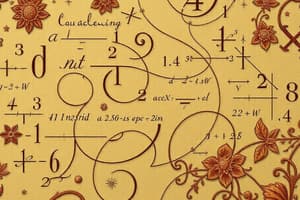Podcast
Questions and Answers
A research team needs to determine the optimal dosage of a new drug to maximize its effectiveness while minimizing side effects. Which branch of mathematics would be most directly applicable to model this?
A research team needs to determine the optimal dosage of a new drug to maximize its effectiveness while minimizing side effects. Which branch of mathematics would be most directly applicable to model this?
- Algebra
- Calculus (correct)
- Geometry
- Arithmetic
An engineer is designing a bridge and needs to ensure that the structure can withstand various loads and stresses. They need to calculate the forces acting on different parts of the bridge and how these forces distribute throughout the structure. Which combination of mathematical fields is MOST essential for this task?
An engineer is designing a bridge and needs to ensure that the structure can withstand various loads and stresses. They need to calculate the forces acting on different parts of the bridge and how these forces distribute throughout the structure. Which combination of mathematical fields is MOST essential for this task?
- Algebra and Geometry (correct)
- Algebra and Calculus
- Geometry and Statistics
- Statistics and Arithmetic
A data analyst is tasked with summarizing the performance of a sales team over the past year. The analyst needs to provide insights into the average sales, the most common sales figure, and the spread of sales values. Which statistical measures are MOST appropriate for this task?
A data analyst is tasked with summarizing the performance of a sales team over the past year. The analyst needs to provide insights into the average sales, the most common sales figure, and the spread of sales values. Which statistical measures are MOST appropriate for this task?
- Mean, Median, Mode, and Standard Deviation (correct)
- Addition, Subtraction, Multiplication and Division
- Quadratic Formula and Factoring
- Integrals, Derivatives and Limits
An architect is designing a circular garden with a path of uniform width surrounding it. The architect knows the total area of the garden including the path and the width of the path. Which mathematical concept is MOST helpful for determining the radius of the inner garden?
An architect is designing a circular garden with a path of uniform width surrounding it. The architect knows the total area of the garden including the path and the width of the path. Which mathematical concept is MOST helpful for determining the radius of the inner garden?
A software engineer is developing a collision detection system for a video game. They need to determine if two moving objects will collide based on their trajectories, velocities, and positions. Which mathematical concepts would be MOST crucial for accurately predicting potential collisions?
A software engineer is developing a collision detection system for a video game. They need to determine if two moving objects will collide based on their trajectories, velocities, and positions. Which mathematical concepts would be MOST crucial for accurately predicting potential collisions?
Flashcards
Arithmetic
Arithmetic
Deals with numbers and basic operations (addition, subtraction, multiplication, division).
Algebra
Algebra
Introduces variables and symbols to represent numbers and solve equations.
Calculus
Calculus
Studies rates of change and accumulation using derivatives and integrals.
Geometry
Geometry
Signup and view all the flashcards
Statistics
Statistics
Signup and view all the flashcards
Study Notes
- Mathematics encompasses a broad range of topics and is essential for understanding the world.
- It includes arithmetic, algebra, calculus, geometry, and statistics.
Arithmetic
- Arithmetic deals with numbers and basic operations: addition, subtraction, multiplication, and division.
- These operations are fundamental to all other branches of mathematics.
- Understanding number properties, such as even, odd, prime, and composite numbers, is crucial.
- Fractions, decimals, and percentages are key concepts within arithmetic.
- Order of operations (PEMDAS/BODMAS) dictates the sequence to perform calculations.
Algebra
- Algebra introduces variables and symbols to represent numbers and quantities.
- It involves solving equations and inequalities to find unknown values.
- Linear equations are of the form ax + b = c, where x is the variable.
- Quadratic equations are of the form ax² + bx + c = 0, and can be solved by factoring, completing the square, or using the quadratic formula.
- Systems of equations involve multiple equations with multiple variables, solved simultaneously.
- Functions describe relationships between variables, mapping inputs to outputs.
Calculus
- Calculus is concerned with rates of change and accumulation.
- Differential calculus deals with derivatives, which measure the instantaneous rate of change of a function.
- Integral calculus deals with integrals, which measure the accumulation of a quantity over an interval.
- Limits are a fundamental concept in calculus, describing the behavior of a function as it approaches a certain value.
- Derivatives are used to find maxima and minima of functions, and to analyze their behavior.
- Integrals are used to calculate areas under curves, volumes, and other quantities.
Geometry
- Geometry studies shapes, sizes, and spatial relationships.
- Euclidean geometry deals with points, lines, angles, surfaces, and solids.
- Key concepts include triangles, quadrilaterals, circles, and other polygons.
- The Pythagorean theorem (a² + b² = c²) relates the sides of a right triangle.
- Trigonometry studies relationships between angles and sides of triangles.
- Transformations such as translations, rotations, and reflections are important in geometry.
- Coordinate geometry uses algebra to describe geometric shapes using coordinates.
Statistics
- Statistics involves collecting, analyzing, interpreting, and presenting data.
- Descriptive statistics summarize and describe data using measures such as mean, median, mode, and standard deviation.
- Inferential statistics involve making inferences and generalizations about a population based on a sample of data.
- Probability measures the likelihood of an event occurring.
- Distributions describe the probability of different outcomes.
- Hypothesis testing involves testing a claim about a population based on sample data.
- Regression analysis examines the relationship between variables.
Mathematical Reasoning and Proofs
- Proofs are logical arguments that demonstrate the truth of a mathematical statement.
- Direct proofs start with assumptions and use logical steps to reach a conclusion.
- Indirect proofs, such as proof by contradiction, assume the opposite of what you want to prove and show that it leads to a contradiction.
- Mathematical induction is used to prove statements about natural numbers.
- Important to distinguish between axioms, theorems, and corollaries in mathematical reasoning.
Discrete Mathematics
- Discrete mathematics deals with discrete objects and structures, as opposed to continuous ones.
- It includes topics such as set theory, logic, combinatorics, graph theory, and number theory.
- Set theory deals with collections of objects.
- Logic studies the principles of valid reasoning and inference.
- Combinatorics involves counting and arranging objects.
- Graph theory studies networks of nodes and edges.
- Number theory explores the properties of integers.
Numerical Analysis
- Numerical analysis develops and analyzes algorithms for solving mathematical problems approximately.
- It is used when exact solutions are difficult or impossible to obtain.
- Key topics include root finding, interpolation, numerical integration, and solving differential equations.
- Algorithms are designed to be stable and accurate.
- Error analysis is crucial to understanding the accuracy of numerical solutions.
Advanced Topics
- Real analysis provides a rigorous foundation for calculus.
- Complex analysis extends calculus to complex numbers.
- Abstract algebra studies algebraic structures such as groups, rings, and fields.
- Topology studies the properties of spaces that are preserved under continuous deformations.
- Differential equations model rates of change and are used in many scientific and engineering applications.
- Probability theory formalizes the study of randomness.
Mathematical Notation
- Mathematical notation provides a concise way to express mathematical ideas.
- Symbols are used to represent operations, variables, constants, and relationships.
- Common symbols include +, -, ×, ÷, =, <, >, ≤, ≥, and ∈.
- Greek letters are often used to represent variables and constants.
- Understanding mathematical notation is essential for reading and writing mathematics.
Problem Solving Strategies
- Understanding the problem is the first step in solving any mathematical problem.
- Developing a plan involves identifying the relevant concepts and techniques.
- Carrying out the plan involves performing the necessary calculations and manipulations.
- Looking back involves checking the answer and verifying that it makes sense.
- Drawing diagrams and making tables can be helpful problem-solving strategies.
- Working backwards and looking for patterns are also useful.
- Breaking down a complex problem into smaller subproblems can make it easier to solve.
Applications of Mathematics
- Mathematics has applications in many fields, including science, engineering, economics, and computer science.
- Physics uses mathematics to model the laws of nature.
- Engineering uses mathematics to design and analyze systems.
- Economics uses mathematics to model markets.
- Computer science uses mathematics to design algorithms and programs.
- Cryptography uses mathematical concepts to secure communications.
Mathematical Software and Tools
- Mathematical software can be used to perform calculations, create graphs, and solve equations.
- Examples include Mathematica, MATLAB, Maple, and Python with libraries like NumPy and SciPy.
- These tools can be used to explore mathematical concepts and solve complex problems efficiently.
- Graphing calculators are also useful for visualizing functions and data.
History of Mathematics
- Mathematics has a rich history, with contributions from many cultures and civilizations.
- Ancient civilizations such as the Egyptians, Babylonians, and Greeks made significant advances in mathematics.
- The development of algebra and calculus in the 17th century marked a major turning point in mathematics.
- Famous mathematicians include Euclid, Archimedes, Newton, Leibniz, Gauss, and Riemann.
Importance of Mathematics Education
- Mathematics education is essential for developing critical thinking and problem-solving skills.
- It prepares students for careers in science, technology, engineering, and mathematics (STEM) fields.
- It also helps students to understand and interpret data in everyday life.
- A strong foundation in mathematics is important for success in many other subjects.
Studying That Suits You
Use AI to generate personalized quizzes and flashcards to suit your learning preferences.




